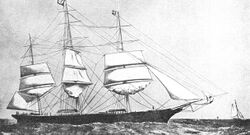Norman Court
Topic: Engineering
 From HandWiki - Reading time: 2 min
From HandWiki - Reading time: 2 min
 Norman Court
| |
| History | |
|---|---|
| Builder: | A. & J. Inglis |
| Cost: | £16,005[1] |
| Launched: | 1869 |
| Out of service: | 1883 |
| Fate: | Sunk; carcass remains in Cymyran Bay |
| General characteristics | |
| Class and type: | Tea Clipper |
| Type: | 833.87 NRT[1] |
| Length: | Hull 197.4 ft 0 in (60.17 m)[1] |
| Beam: | 33 ft 0 in (10.06 m)[1] |
| Depth: | 20 ft 0 in (6.10 m)[1] |
| Propulsion: | Sails |
| Sail plan: |
|
| Notes: | designed by William Rennie |
Norman Court was a composite built clipper ship, designed by William Rennie, measuring 197.4 ft x 33 ft x 20 ft, of 833.87 tons net. The ship was built in 1869 by A. & J. Inglis of Glasgow. On the night of 29 March 1883 in a strong gale she was driven ashore and wrecked in Cymyran Bay, between Rhoscolyn and Rhosneigr, Anglesey. All bar two of the crew were saved by lifeboats from nearby Holyhead. Andrew Shewan was captain of the Norman Court from her launch until he retired in ill-health in 1873, following an extraordinarily difficult passage from China. His son, also Andrew Shewan, who had previously sailed as first mate, became captain. It was this son Andrew Shewan who recounted many tales of the ship and of the clipper ships in his book Great Days Of Sail: Reminiscences of a Tea Clipper Captain, published in 1926 when he could plausibly claim to be the last surviving tea clipper captain. He died in December 1927.
References
External links
- The Final Voyage of the "Norman Court"
- Story of the wreck of the 'Norman Court' at Cymyran
- Painting of clipper ship Norman Court, San Francisco Public Library
- The Wreck of the Norman Court - Worsley Sub-aqua club page with photographs of the wreck
- [ ⚑ ] 53°14′09″N 4°32′55″W / 53.235743°N 4.548656°W - approximate location of the wreck
 |
 KSF
KSF
